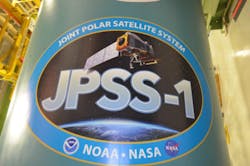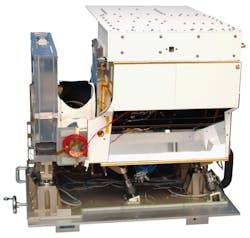Exelis Space Systems to deliver infrared instruments for NOAA Joint Polar Satellite System payloads
FORT WAYNE, Ind., 29 Jan. 2016. NASA awarded a sole source contract modification to Exelis Space Systems Inc., a wholly owned subsidiary of the Harris Corp. (NYSE:HRS) in Fort Wayne, Indiana, for two Cross-track Infrared Sounder (CrIS) Instruments for flight on the Polar Follow-On extension of the National Oceanic & Atmospheric Administration’s (NOAA’s) Joint Polar Satellite System (JPSS)-3 and -4 missions.
Engineers at Exelis Space Systems will build two instruments for payloads onboard the fourth and fifth weather satellites under a $316 million cost-plus-award-fee contract modification, awarded by the NASA Goddard Space Flight Center in Greenbelt, Md., on behalf of NOAA, in support of the JPSS-3 and JPSS-4 missions. The total value of this contract is increased from $385,203,769 by $316,030,564 to $701,234,333, and extends the period of performance to 18 months after the launch of JPSS-4, NASA officials say.
Exelis Space Systems engineers will manufacture, test, and deliver two CrIS instruments, support instrument integration on the JPSS-3 and 4 spacecraft, and provide launch and post-launch support. The CrIS instruments will be new builds of the CrIS design currently flying on the NOAA/NASA Suomi NPP Mission and planned for National Oceanic and Atmospheric Administration's (NOAA) JPSS-1 and 2 missions.
The Cross-track Infrared Sounder (CrIS) instrument produces high-resolution, three-dimensional (3D) temperature, pressure, and moisture profiles used to enhance weather forecasting models.
The high-spectral resolution infrared instrument will measure atmospheric temperature, water vapor, and trace gases. Forecasters use this data in computer models to improve global and regional predictions of weather patterns, storm tracks and precipitation. This information significantly improves short- and long-term weather forecasting.
The first CrIS instrument is currently operational on the joint NOAA/NASA Suomi National Polar-orbiting Partnership satellite launched in 2011. The second CrIS instrument is scheduled for launch in early 2017 onboard the JPSS-1 spacecraft. The third CrIS instrument is in development for the JPSS-2 spacecraft, scheduled for launch in 2021.
“CrIS provides vital data for numerical prediction models key to both short- and long-term weather forecasting,” says Eric Webster, Harris Environmental Solutions vice president and general manager. “CrIS data also will be important for understanding climate phenomena such as El Niño and La Niña.”
JPSS is a collaborative effort between NOAA and NASA that ensures continuity of observational data at the quality levels needed to sustain current weather forecasts beyond 2017. NOAA is responsible for managing and operating the JPSS satellites, while NASA is responsible for developing and building the JPSS instruments, spacecraft and major components of the ground segment, as well as launching the satellite. Work on the payloads is performed in Fort Wayne, Indiana.
The JPSS missions are funded by NOAA to provide global environmental data in low Earth polar orbit in support of NOAA's mission. NASA is the acquisition agent for the flight systems and components of the ground segment.
Harris Corporation is a technology innovator, solving customers’ mission-critical challenges by providing solutions that connect, inform, and protect. Harris supports customers in more than 125 countries, has approximately $8 billion in annual revenue and 22,000 employees worldwide. The company is organized into four business segments: Communication Systems, Space and Intelligence Systems, Electronic Systems, and Critical Networks.
Related news & information:
You might also like:
Subscribe today to receive all the latest aerospace technology and engineering news, delivered directly to your e-mail inbox twice a week (Tuesdays and Thursdays). Sign upfor your free subscription to the Intelligent Inbox e-newsletter at http://www.intelligent-aerospace.com/subscribe.html.
Connect with Intelligent Aerospace on social media: Twitter (@IntelligentAero), LinkedIn,Google+, and Instagram.

